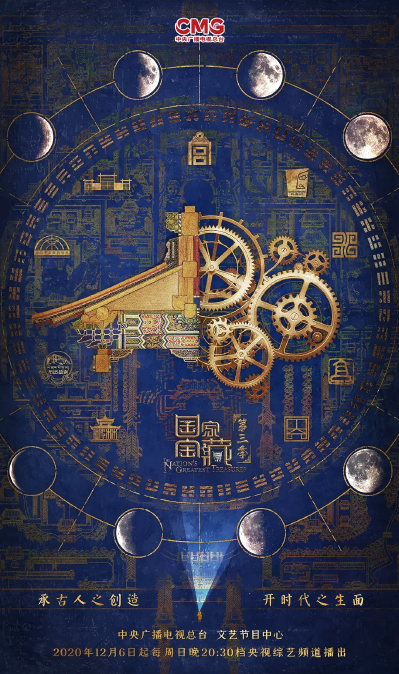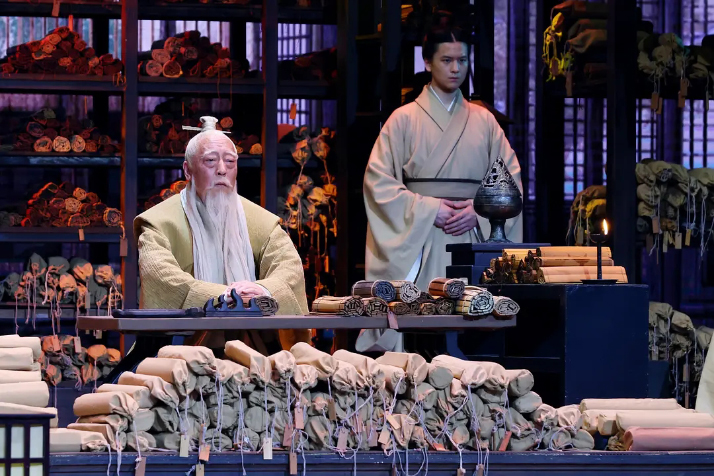| Lifestyle |
| TV shows on Chinese classics gain popularity among young generation | |
|
|
 A poster of The Nation's Greatest Treasures (FILE)
If you have a chance to talk with a historical figure, who would you like it to be? What would you like to know about the past or share from today? China in the Classics, a new TV show based on Chinese classics started by China Central Television (CCTV) in February, is exploring such premises. In the first episode, the host of the show, Sa Beining, meets ancient Confucian scholar Fu Sheng, who interprets the Shangshu, the Book of Documents. Regarded as one of the five classics of ancient Chinese Confucianism masterpieces, the book records many firsts in the country; even the expression zhongguo (China) is used there first. The Shangshu's importance lies in passing down the Chinese political philosophy and daily life social norms for over 2,000 years. However, such an important book was close to extinction when China's first Emperor Qin Shihuang (B.C. 259-210) decided to have all Confucianism books burnt to set up a social governance system based on legalism. Fu risked his life to hide the scrolls and keep them safe through wars and social upheavals. Some believe he memorized them to ensure the text survived. The episode ends with the host bringing Fu to today's modern society, where the scholar is happy to find children reciting the same things he had learned in his childhood. It boosted the rating of the series with viewers giving it 9 out of 10 on Douban, a film and TV show reviewing website popular among young people, though Fu was an unfamiliar character to them. The tribute was to the philosopher's mental strength and perseverance, which is part of the national spirit and cultural ethos.  A scene from the China in the Classics series by China Central Television shows ancient scholar Fu Sheng played by actor Ni Dahong (FILE)
Reframing culture The success of China in the Classics doesn't surprise Shen Haixiong, head of the China Media Group, the parent company of CCTV. Shen said in an article in the journal Qiushi, "We are happy to see the program is popular among the public, but we are more proud to find that innovative interpretation of Chinese classics are arousing young people's interest in the Chinese culture." Shen had proposed the series at an editorial meeting of CCTV last year. The objective was to remind viewers that the ancient Chinese culture is not obscure or antique and classics can tell them both about the past and the future of the country. The series is a journey through time and space where unusual experts interpret the classics to help viewers better understand their meaning and spirit. To Hu Weixiang, a 34-year-old engineer in Yangzhou, Jiangsu Province, east China, the most impressive story was about Yu the Great recorded in the first episode, who divided China into nine provinces, a prototype of China's territorial division throughout history. The legendary king was the founder of the Xia Dynasty (around B.C. 2070-1600), which started dynastic rule in China, and was famous for taming the great flood. "I did not know much about the Shangshu and had no idea of Yu the Great's contribution to the system of regional divisions for administration. But after watching the show, I found the book interesting and want to read it," he told Beijing Review. According to the Shangshu, Hu's hometown was then part of a province also called Yangzhou, combining the area of today's Jiangsu and Zhejiang provinces and Shanghai in east China. It had the land with the poorest soil in the country at that time but today is one of the most prosperous regions in China. "I learned more about my own hometown than I could have learned by myself," he said. Experts' contribution The historical and literary research involved in the series and the complex dramas require a lot of work by scholars and experts from those fields, as well as experienced scriptwriters and excellent performers. The National Theater of China and Chinese Academy of History have collaborated on the series. Tian Qinxin, head of the National Theater of China, is the art director of the show. To avoid a stereotype show focusing on academic aspects, Tian and her colleagues use hi-tech devices to create an immersive experience so that viewers can resonate with historical figures. Tian told China Daily they want to help people understand the significance of classics and how these have influenced Chinese cultural traditions while remaining true to history. "They remind us not to forget our origins and explain where our cultural confidence comes from," she said. "They are the foundations of modern China." Hu's interest in cultural TV shows grew in 2001 after he watched Lecture Room. It was a program where scholars discussed culture, biology, the economy and other subjects. However, the show had a simple form and may not appeal to today's younger generations who have grown up in the Internet culture. Therefore, TV channels have been making bold attempts in recent years to attract them. The Nation's Greatest Treasures, CCTV's cultural show in 2017, showcased China's history and culture through artifacts in the top-tier museums, and fired up the audience. The third season released in last December has selected nine key historical sites to record the development of Chinese civilization. They include the 3,300-year-old Yinxu Ruins in Henan Province, central China, where the earliest known Chinese writing was excavated, and the 1,300-year-old Potala Palace in Lhasa, Tibet Autonomous Region, southwest China. The Palace Museum in Beijing, which celebrated its 600th anniversary last year, is the youngest member among the sites. Zhou Xing, a professor at the School of Arts and Communication, Beijing Normal University, thinks the success of China in the Classics indicates the team's confidence in Chinese culture and viewers' interest in tradition, especially young people. CCTV should make a variety of programs showcasing classics and cultural traditions, Zhou said. They could serve as models for other television stations and Internet platforms that produce shows on Chinese culture to appeal to the young generation's aesthetics. Local television stations have also contributed to the cultural feast. For instance, Beijing Television Station's I Will Wait for You in the Summer Place introduced traditional architecture and royal aesthetics, while its Great Wall series portrayed the Great Wall culture. (Printed Edition Title: A Remote Handshake) Copyedited by Sudeshna Sarkar Comments to liqing@bjreview.com |
|
||||||||||||||||||||||||||||
|